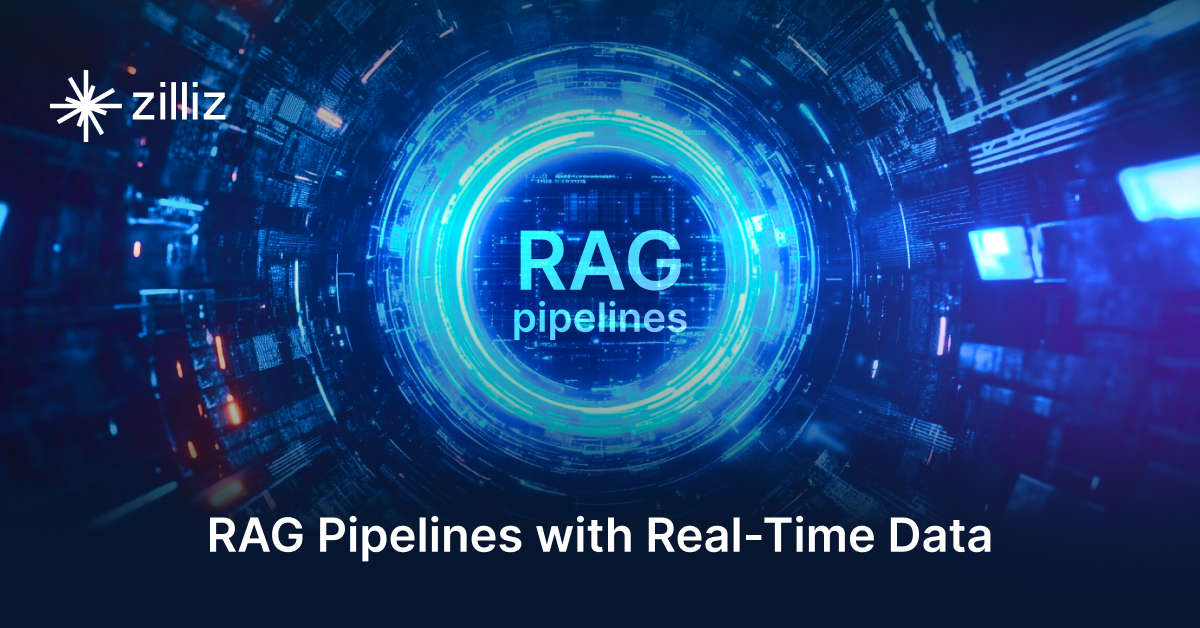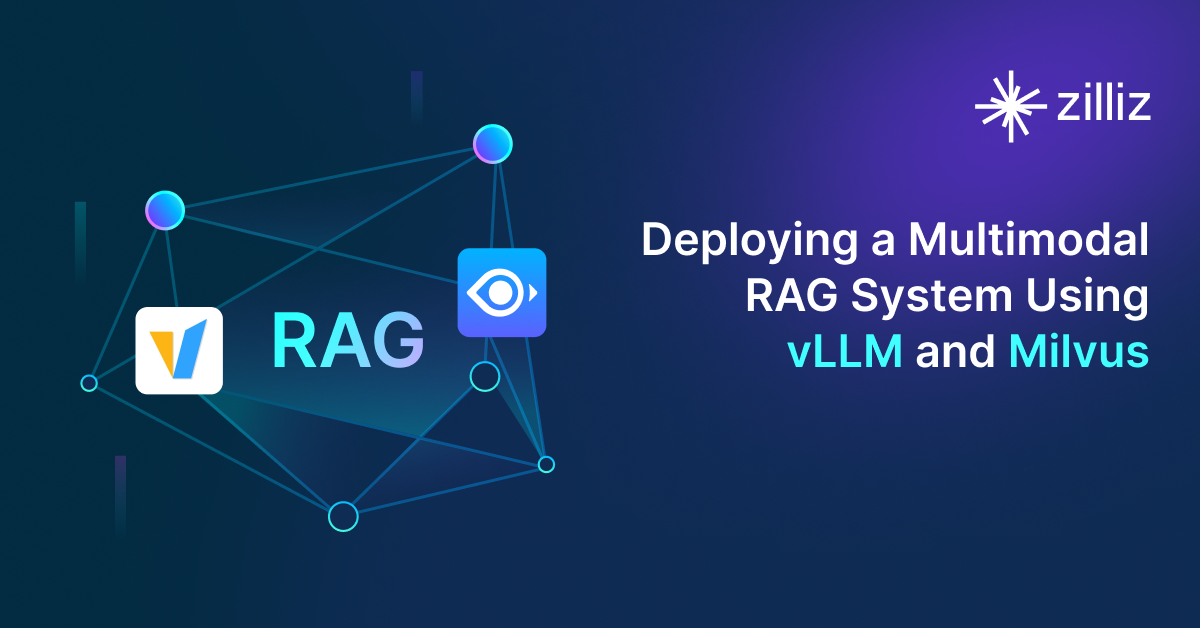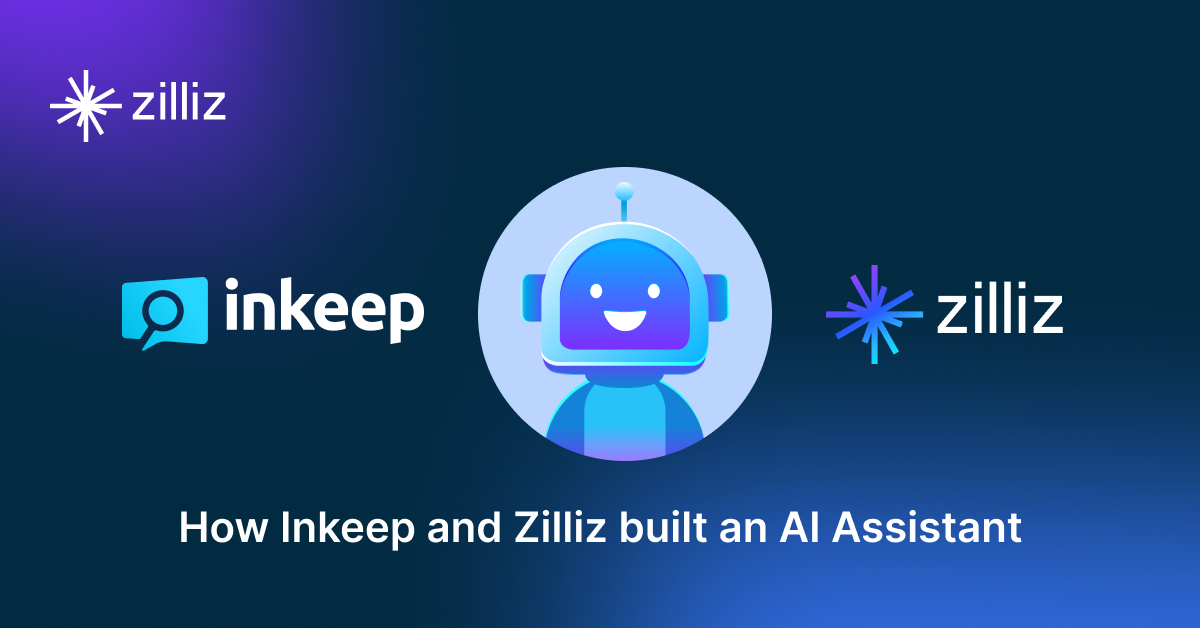Build RAG Chatbot with LangChain, LangChain vector store, Mistral AI Pixtral Large, and Nomic Nomic Embed
Introduction to RAG
Retrieval-Augmented Generation (RAG) is a game-changer for GenAI applications, especially in conversational AI. It combines the power of pre-trained large language models (LLMs) like OpenAI’s GPT with external knowledge sources stored in vector databases such as Milvus and Zilliz Cloud, allowing for more accurate, contextually relevant, and up-to-date response generation. A RAG pipeline usually consists of four basic components: a vector database, an embedding model, an LLM, and a framework.
Key Components We'll Use for This RAG Chatbot
This tutorial shows you how to build a simple RAG chatbot in Python using the following components:
- LangChain: An open-source framework that helps you orchestrate the interaction between LLMs, vector stores, embedding models, etc, making it easier to integrate a RAG pipeline.
- LangChain in-memory vector store: an in-memory, ephemeral vector store that stores embeddings in-memory and does an exact, linear search for the most similar embeddings. The default similarity metric is cosine similarity, but can be changed to any of the similarity metrics supported by ml-distance. It is intended for demos and does not yet support ids or deletion. (If you want a much more scalable solution for your apps or even enterprise projects, we recommend using Zilliz Cloud, which is a fully managed vector database service built on the open-source Milvusand offers a free tier supporting up to 1 million vectors.)
- Mistral AI Pixtral Large: This advanced model is engineered for high-quality image and text generation. With its robust architecture, it excels in tasks such as creative content generation, image enhancement, and multimedia integration. Ideal for applications in marketing, design, and entertainment, Pixtral Large delivers impressive results while maintaining a user-friendly experience.
- Nomic Nomic Embed: Nomic Embed is an advanced AI model designed for generating high-dimensional embeddings that capture semantic relationships within textual data. Its strengths lie in providing robust text representation, enabling superior performance in natural language understanding tasks such as information retrieval, sentiment analysis, and recommendation systems. Ideal for applications in content personalization and knowledge discovery, Nomic Embed streamlines the process of deriving insights from large datasets.
By the end of this tutorial, you’ll have a functional chatbot capable of answering questions based on a custom knowledge base.
Note: Since we may use proprietary models in our tutorials, make sure you have the required API key beforehand.
Step 1: Install and Set Up LangChain
%pip install --quiet --upgrade langchain-text-splitters langchain-community langgraph
Step 2: Install and Set Up Mistral AI Pixtral Large
pip install -qU "langchain[mistralai]"
import getpass
import os
if not os.environ.get("MISTRAL_API_KEY"):
os.environ["MISTRAL_API_KEY"] = getpass.getpass("Enter API key for Mistral AI: ")
from langchain.chat_models import init_chat_model
llm = init_chat_model("pixtral-large-latest", model_provider="mistralai")
Step 3: Install and Set Up Nomic Nomic Embed
pip install -qU langchain-nomic
import getpass
import os
if not os.environ.get("NOMIC_API_KEY"):
os.environ["NOMIC_API_KEY"] = getpass.getpass("Enter API key for Nomic: ")
from langchain_nomic import NomicEmbeddings
embeddings = NomicEmbeddings(model="nomic-embed-text-v1")
Step 4: Install and Set Up LangChain vector store
pip install -qU langchain-core
from langchain_core.vectorstores import InMemoryVectorStore
vector_store = InMemoryVectorStore(embeddings)
Step 5: Build a RAG Chatbot
Now that you’ve set up all components, let’s start to build a simple chatbot. We’ll use the Milvus introduction doc as a private knowledge base. You can replace it with your own dataset to customize your RAG chatbot.
import bs4
from langchain import hub
from langchain_community.document_loaders import WebBaseLoader
from langchain_core.documents import Document
from langchain_text_splitters import RecursiveCharacterTextSplitter
from langgraph.graph import START, StateGraph
from typing_extensions import List, TypedDict
# Load and chunk contents of the blog
loader = WebBaseLoader(
web_paths=("https://milvus.io/docs/overview.md",),
bs_kwargs=dict(
parse_only=bs4.SoupStrainer(
class_=("doc-style doc-post-content")
)
),
)
docs = loader.load()
text_splitter = RecursiveCharacterTextSplitter(chunk_size=1000, chunk_overlap=200)
all_splits = text_splitter.split_documents(docs)
# Index chunks
_ = vector_store.add_documents(documents=all_splits)
# Define prompt for question-answering
prompt = hub.pull("rlm/rag-prompt")
# Define state for application
class State(TypedDict):
question: str
context: List[Document]
answer: str
# Define application steps
def retrieve(state: State):
retrieved_docs = vector_store.similarity_search(state["question"])
return {"context": retrieved_docs}
def generate(state: State):
docs_content = "\n\n".join(doc.page_content for doc in state["context"])
messages = prompt.invoke({"question": state["question"], "context": docs_content})
response = llm.invoke(messages)
return {"answer": response.content}
# Compile application and test
graph_builder = StateGraph(State).add_sequence([retrieve, generate])
graph_builder.add_edge(START, "retrieve")
graph = graph_builder.compile()
Test the Chatbot
Yeah! You've built your own chatbot. Let's ask the chatbot a question.
response = graph.invoke({"question": "What data types does Milvus support?"})
print(response["answer"])
Example Output
Milvus supports various data types including sparse vectors, binary vectors, JSON, and arrays. Additionally, it handles common numerical and character types, making it versatile for different data modeling needs. This allows users to manage unstructured or multi-modal data efficiently.
Optimization Tips
As you build your RAG system, optimization is key to ensuring peak performance and efficiency. While setting up the components is an essential first step, fine-tuning each one will help you create a solution that works even better and scales seamlessly. In this section, we’ll share some practical tips for optimizing all these components, giving you the edge to build smarter, faster, and more responsive RAG applications.
LangChain optimization tips
To optimize LangChain, focus on minimizing redundant operations in your workflow by structuring your chains and agents efficiently. Use caching to avoid repeated computations, speeding up your system, and experiment with modular design to ensure that components like models or databases can be easily swapped out. This will provide both flexibility and efficiency, allowing you to quickly scale your system without unnecessary delays or complications.
LangChain in-memory vector store optimization tips
LangChain in-memory vector store is just an ephemeral vector store that stores embeddings in-memory and does an exact, linear search for the most similar embeddings. It has very limited features and is only intended for demos. If you plan to build a functional or even production-level solution, we recommend using Zilliz Cloud, which is a fully managed vector database service built on the open-source Milvus and offers a free tier supporting up to 1 million vectors.)
Mistral AI Pixtral Large optimization tips
Pixtral Large is a high-performance multimodal model optimized for advanced reasoning across text and image inputs. Optimize retrieval by ensuring efficient document and image indexing, leveraging hybrid search to find the most relevant multimodal content. Use structured context formatting to provide clear relationships between retrieved text and images, preventing ambiguity in model responses. Adjust inference settings by dynamically controlling retrieval depth—fetching broader context for complex multimodal queries and focusing on narrower, high-precision retrieval for simpler ones. Optimize token efficiency by filtering out redundant data before passing it to the model, ensuring inference speed remains high. Use caching for frequently requested multimodal queries to reduce processing overhead. If deploying Pixtral Large in production, distribute inference across multiple nodes to handle large-scale workloads effectively while maintaining latency targets.
Nomic Nomic Embed optimization tips
To optimize the Nomic Nomic Embed component in a Retrieval-Augmented Generation (RAG) setup, focus on fine-tuning your embedding model with domain-specific data to enhance contextual relevance. Implement efficient indexing strategies, such as using FAISS or Annoy, to speed up retrieval times without compromising accuracy. Experiment with dimensionality reduction techniques, like PCA or t-SNE, to decrease computational load while retaining essential semantic information. Regularly clean and preprocess your corpus to eliminate noise and improve embedding quality. Lastly, monitor embedding drift over time and update your embeddings periodically to ensure they reflect the latest knowledge in your target domain.
By implementing these tips across your components, you'll be able to enhance the performance and functionality of your RAG system, ensuring it’s optimized for both speed and accuracy. Keep testing, iterating, and refining your setup to stay ahead in the ever-evolving world of AI development.
RAG Cost Calculator: A Free Tool to Calculate Your Cost in Seconds
Estimating the cost of a Retrieval-Augmented Generation (RAG) pipeline involves analyzing expenses across vector storage, compute resources, and API usage. Key cost drivers include vector database queries, embedding generation, and LLM inference.
RAG Cost Calculator is a free tool that quickly estimates the cost of building a RAG pipeline, including chunking, embedding, vector storage/search, and LLM generation. It also helps you identify cost-saving opportunities and achieve up to 10x cost reduction on vector databases with the serverless option.
 Calculate your RAG cost
Calculate your RAG cost
What Have You Learned?
By diving into this tutorial, you’ve just unlocked the power of combining cutting-edge tools to build a fully functional RAG system! You learned how LangChain acts as the glue that holds everything together, orchestrating workflows between your data, embeddings, and language models. The vector database (like LangChain’s built-in vector store) became your dynamic memory, storing and retrieving context-rich embeddings generated by Nomic Nomic Embed—a model designed to capture nuanced semantic relationships in your data. Then, Mistral AI’s Pixtral Large stepped in as the brain, synthesizing retrieved information into coherent, human-like responses. Together, these components formed a seamless pipeline: your data gets embedded, stored, retrieved, and transformed into answers that feel almost magical. You even explored optimization tricks, like chunking strategies and embedding tuning, to squeeze every drop of efficiency from your system. And let’s not forget the free RAG cost calculator—a handy tool to keep your projects budget-friendly without sacrificing performance!
But this is just the beginning. You’re now equipped to tackle real-world challenges, whether it’s building smarter chatbots, personalized recommendation engines, or research assistants that dig through mountains of data. Imagine tweaking retrieval thresholds, experimenting with hybrid search, or fine-tuning Mistral’s outputs for your niche—your creativity is the limit. The tools are here, the roadmap is clear, and the AI community is buzzing with possibilities. So fire up your IDE, load up your datasets, and start iterating. Every line of code you write brings you closer to mastering RAG and shaping the future of intelligent applications. The world of AI is your playground—go build something incredible! 🚀
Further Resources
🌟 In addition to this RAG tutorial, unleash your full potential with these incredible resources to level up your RAG skills.
- How to Build a Multimodal RAG | Documentation
- How to Enhance the Performance of Your RAG Pipeline
- Graph RAG with Milvus | Documentation
- How to Evaluate RAG Applications - Zilliz Learn
- Generative AI Resource Hub | Zilliz
We'd Love to Hear What You Think!
We’d love to hear your thoughts! 🌟 Leave your questions or comments below or join our vibrant Milvus Discord community to share your experiences, ask questions, or connect with thousands of AI enthusiasts. Your journey matters to us!
If you like this tutorial, show your support by giving our Milvus GitHub repo a star ⭐—it means the world to us and inspires us to keep creating! 💖
- Introduction to RAG
- Key Components We'll Use for This RAG Chatbot
- Step 1: Install and Set Up LangChain
- Step 2: Install and Set Up Mistral AI Pixtral Large
- Step 3: Install and Set Up Nomic Nomic Embed
- Step 4: Install and Set Up LangChain vector store
- Step 5: Build a RAG Chatbot
- Optimization Tips
- RAG Cost Calculator: A Free Tool to Calculate Your Cost in Seconds
- What Have You Learned?
- Further Resources
- We'd Love to Hear What You Think!
Content
Vector Database at Scale
Zilliz Cloud is a fully-managed vector database built for scale, perfect for your RAG apps.
Try Zilliz Cloud for Free


